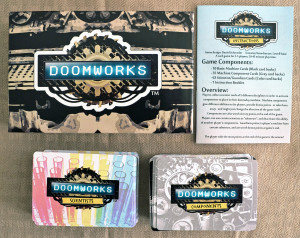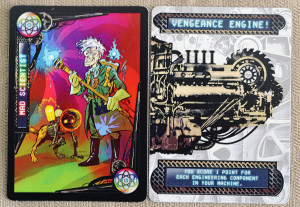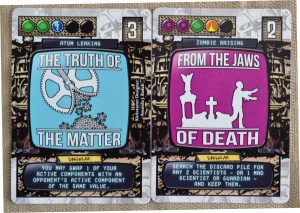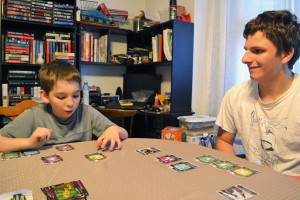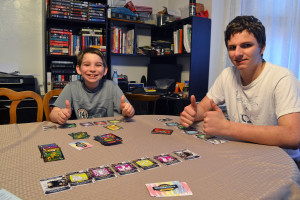Kirk: “Bones, did you ever hear of a doomsday machine?”
McCoy: “No. I’m a doctor, not a mechanic.”
Kirk: “It’s a weapon built primarily as a bluff. It’s never meant to be used. So strong, it could destroy both sides in a war. Something like the old H-Bomb was supposed to be. That’s what I think this is. A doomsday machine that somebody used in a war uncounted years ago. They don’t exist anymore, but the machine is still destroying.”
-Star Trek, “The Doomsday Machine”, Airdate: Oct. 20, 1967
(Sorry, I couldn’t resist)
“Doomworks”, put simply, is a card game that tasks players with building a doomsday device. Each player will be endeavouring to complete their machine before everyone else while attempting to earn the most victory points in the process. This Kickstarter success nearly doubled its funding goal and just recently hit the virtual shelves with an Earth-shattering kaboom. Before I get into all of that however, I’d like to thank Daniel Schroeder from One Man Act Games for providing me with a free review copy.
Components
Component Cards – The component deck is made up of machine front & back cards and basic component cards. Each player will receive a machine front card and a machine back card to form the machine’s shell. Players will be attempting to fill this shell with basic component cards. More on that in a bit.
Scientist Cards – The scientist deck is made up of scientist cards of varying colors and abilities. Some scientists have the saboteur ability, some act as doombringers, and others have no special ability at all. You can see whether or not a scientist has an ability by looking for an icon in the upper left portion of the card.
Setup & Gameplay
First, each player will receive a random machine front card and a random machine back card. They’ll be placed on the table in front of them, spaced apart so that five cards can fit between them (use your best judgement). This will be referred to as the player’s active zone. Next, players are dealt five basic component cards each. Players select one card from their hand, keep one, and pass the remaining ones to the next player. This process continues until everyone is out of cards to pass around. With their new hands of five, players will lay them out face-up directly under their active zone. This new row will be referred to as the inactive zone. Finally, each player is dealt five scientist cards to form their hand. Players can use any method they wish (the best evil laugh, etc.) to determine the starting player.
During a player’s turn, they’ll able to perform TWO of the following actions:
1) Draw a Scientist Card – The current player can draw a card from either the deck or take the top card from the discard pile.
2) Assign Scientists – The current player can play cards from their hand to activate inactive basic component cards. The type of scientists used much match a particular basic component card’s requirements, which are listed along the top of the card.
3) Assign a Saboteur Scientist – The current player can play a saboteur card on another player’s active basic component card. It stays on the active basic component card until removed. Saboteurs cancel any effect that the active basic component card grants, as well as costs the player negative two points during endgame scoring.
4) Assign Repair Scientists – The current player can play a scientist card of the same type as the saboteur card to remove it from their activate component. Alternately, a player can play two scientist cards of any type to remove the saboteur card.
5) Assign a Guardian – The current player can play a guardian card above their active zone. Guardians are part of the scientist deck and protect players from saboteurs of the same type. They also factor in pretty heavily during endgame scoring.
Players continue taking turns (clockwise) until one player completes their machine or until a certain number of doombringers have entered play. A doombringer is a special type of scientist card that, instead of being discarded when used, is placed into a collective pile in the middle of the table. Think of them as scientists that made mistakes while crafting components. If enough mistakes occur, it’s assumed that one of the machines simply activated early.
When it’s time to compare scores, the inactive basic components are set aside. Players don’t receive a penalty for incomplete machines. Players do however add up the point values listed on their active basic components (top right corner). They also earn one point per guardian AND one point for each component of the same type as the guardians they have. If I had a blue guardian and one active blue component for example, I’d score one for the guardian and one for the blue active component for a total of two points. Players also factor in their front and back machine cards, which provide bonus points for satisfying certain objectives. There’s also saboteurs and regular component point effects to consider, if they happen to be in existence. The player with the most points wins the game!
The above is simply an overview of the game, but should give you an idea as to how it is played. You can learn more by visiting the links listed at the end of this article.
The Review
Firstly, the size of the box is relatively small, making it ideal for travel. You obviously couldn’t play it in a moving vehicle, but it fits nicely into a travel bag. The artwork on the cards (by Lowell Isaac) is impressive and nicely done. The cards were of good quality and shuffled easily, while the colors were bright and stood out across the room. Two baggies came with my copy that served to hold the cards inside the box. I liked the addition of baggies personally, as it prevents the cards from getting mixed up when the box gets jostled around for various reasons. The manual was a small booklet, but it did a good job in explaining the rules. I especially liked the game summary at the end of the booklet, which I refered to from time to time to stay on track.
For as simple as the game plays, there’s quite a bit going on. I think this is mainly due to how many different ways victory points can be earned. One of the game ending conditions is when someone completes their device, which means that some players might decide to forego looking at the bonuses on their machine front and back cards in an attempt to finish it promptly. This might result in a quick victory for the player doing so, due to the volume of component cards the completed machine has as opposed to everyone else. Then again, completing your machine first doesn’t always guarantee victory, especially if you’ve ignored the majority of available bonuses.
I found myself at ends quite often with what I wanted to do and which components I wanted to activate. While you do have a good chance of getting the basic component cards you want during the process I’ve dubbed as the “five-card shuffle”, there are no guarantees that they’ll sync with either machine bonus or that you’ll draw guardian cards of those colors. Each component has a different point value too, so there’s that to consider. Ideally, one would wait to get everything they need so that they could hit victory points from all sides…but with others going at it along side you, you may have to sacrifice in some places to stay competitive. Components also have either a one-time or continuous effect, forcing me to think about which components I wanted in play first.
Both Vinnie (12) and Anthony (17) had a great time playing, often opting to groan loudly for comedic effect every time a doombringer entered play. There was some tension between the two boys when the special abilities began interfering with their best-laid plans. For example, Vinnie saw that Anthony was close to finishing his machine and decided to activate a basic component of his own. The special ability that came with it required the other players to discard all scientists of a particular color from their hands. Vinnie saw that Anthony required yellow scientists to finish his last component, so he commanded that we discard that color accordingly. Needless to say, Anthony was none to happy about it. Regardless of the sniping that took place throughout the game, both of the boys really enjoyed themselves.
Overall, “Doomworks” is innovative card game that’s easy to pick up and play. It has enough depth to attract those who like to analyze everything to death (myself included), but is also simple enough to where casual folks can play without too much trouble. There’s some luck in drawing the right cards, but the majority of the game is spent thinking about how you want to play the cards you’ve been dealt. The game is well suited for kids, but I’d recommend parental supervision to prevent any fights from breaking out, especially if your kids are easy to provoke. It’s extremely easy to attack another player in this game, which can spell disaster for those with short tempers. Normally I’d raise concern over the price of card games that happen to be over fifteen dollars, but this game is more on par with “Innovation” in regards to the number of cards offered in the package. For $19.99 (as of 6/17/13), there’s enough here to ensure that games are never the same twice. To sum things up, “Doomworks” is a lot of fun and definitely worth checking out. I’ll even go as far as to say that it’s probably one of the best card games that I’ve played to date.
Final Verdict: 9/10
—
—
You can learn more about and purchase “Doomworks” by visiting the following websites:
https://www.thegamecrafter.com/games/doomworks
http://boardgamegeek.com/boardgame/140725/doomworks
http://www.kickstarter.com/projects/1844829516/doomworks-a-fun-doomsday-device-building-card-game

